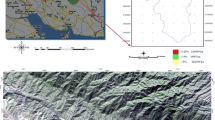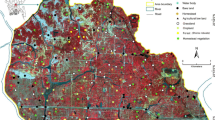Abstract
A study was conducted to analyze high spectral reflectance data of the floor cover of dry deciduous forests (Shoolpaneshwar wildlife sanctuary, Gujarat, India) during the summer season. Hyperion data and field data were acquired in the month of April, 2006 (dry/summer season) when the vegetation was in different stages of senescence. Variations in spectral characteristics of different types of leaf litter were seen. Spectral reflectance curves were different for different thicknesses of leaf litter. Altitude also had an impact on the reflectance curves. Spectra of bare soil is easily separable from the ones covered by litter. Descriptive spectra were extracted for four cover types such as Tectona grandis L., Dendrocalamus strictus Nees., mixed deciduous species and bare soil. Continuum removal spectra were also extracted for these four types. Sharp absorption features were seen in VIS and SWIR-II wavelengths which were absent in the spectra of bare soil, indicating the ability of Hyperion data to discriminate dry forest floor from bare soil. The three cover types are also distinctly separable. SWIR-II wavelengths are more sensitive to the type of floor cover indicating its distinctiveness. Results are discussed highlighting the potential of Hyperion data in deciphering floor cover characteristics in the dry season.
Similar content being viewed by others
References
Asner GP and Lobell DB (2000) A biogeophysical approach for automated SWIR unmixing of soils and vegetation. Rem. Sen. Env. 74:94–112
Bahuguna VK (1999) Fire situation in India. International Forest Fire News. 26:23–27
Brandis K and Jacobson C (2003) Estimation of vegetative fuel loads using Landsat TM imagery in New South Wales. Aust. Int. J. Wildland Fire, 12:185–194
Brown JK and Bevins CD (1986) Surface fuel loadings and predicted fire behavior for vegetation types in the northern Rocky Mountains. US Department of Agriculture, Forest Service, Intermountain Forest and Range Experiment Station, Ogden, UT. Res. Note: INT-358, p 9
Clark RN (1999) Spectroscopy of rocks and minerals and principles of spectroscopy. In: Remote Sensing for the Earth Sciences: Manual of Remote Sensing 3rd Edition, Vol. 3 (A.N. Rencz, Ed.), John Wiley and Sons, Inc., New York, pp 3–58
Clark RN and Roush TL (1984) Reflectance spectroscopy: Quantitative analysis techniques for remote sensing applications. J. Geo. Research 89:6329–6340
Datt B, McVicar TR, Jupp DLB and Pearlman JS (2003) Pre-processing EO-1 Hyperion hyperspectral data to support the application of agricultural indexes. IEEE Trans. Geosci. Remote Sensing 41(2):1246–1259
Daughtry CST, Hunt Jr ER and McMurtrey III JE (2004) Assessing crop residue cover using shortwave infrared reflectance, Rem. Sen. Env. 90:126–134
Garg RK and Vyas LN (1975) Litter production in deciduous forest near Udaipur (south Rajasthan), India. Tropical Ecological Systems. New York: Springer-Verlag, pp 131–135
Holdridge LR (1967) Life Zone Ecology. Tropical Science Center, San Jose, Costa Rica, p 206
Ingle JD (1988) Spectrochemical Analysis, Prentice-Hall, Inc., Engelwood Cliffs, New Jersey, pp. 424–425
Kaene RE, Burgan R and van Wagtendok J (2001) Mapping wildland fuels for fire management across multiple scales: integrating remote sensing, GIS, and biophysical modeling. Int. J. Willand Fire, 10:301–319
Kaene RE, Rollins MG, McNicoll CH and Persons RA (2002) Integrating ecosystem sampling, gradient modeling, remote sensing, and ecosystem simulation to create spatially explicit landscape inventories. US Department of Agriculture, Forest Service, Rocky Mountain Research Station, Fort Collins, CO. RMRS-GTR-92, p. 61
Kokaly RF (2001) Investigating a physical basis for spectroscopic estimates of leaf nitrogen concentration. Rem. Sen. Env., 67:153–161
Kokaly RF, Despain DG, Clark RN and Livo KE (2003) Mapping vegetation in Yellowstone National Park using spectral feature analysis of AVIRIS data. Rem. Sen. Env. 84:437–456
Lee KS, Kin SH, Ma JR, Kook MJ and Shin J (2005) Spectral variation of vegetative areas in leaf-off season observed by hyperspectral data. IEEE, pp. 4347–4350
Lewis MM and Dunk I (2000) Seagrass and shallow water feature discrimination using HyMap. Proceedings Tenth Australasian Remote Sensing and Photogrammetry Conference, 21–25, Adelaide, Australia, 1, 1092–1108 (CD-ROM)
Lumme JH (2004) Classification of vegetation & soil using imaging spectrometer data. Proceedings XXth ISPRS Congress, Istanbul, Turkey from July 12–23, 2004
Pradeepkumar G (1993) Vegetational & Ecological Studies of Shoolpaneshwar Wildlife Sanctuary. Ph.D Thesis, Botany Department, The M.S. University of Baroda, India
Pyne SJ, Andrews PL and Laven RD (1996) Introduction to Wildland Fire. John Wiley & Sons Inc., New York, pp. 1–769
Roberts DA, Dennison PE, Gardner ME, Hetzel Y, Ustin, SL and Lee CT (2003) Evaluation of the potential of Hyperion for fire danger assessment by comparison to the Airborne Visible/Infrared Imaging Spectrometer. IEEE Trans Geosci Remote Sensing 41(6):1297–1309
Sabnis SD and Amin JC (1992). Eco-Environmental studies of Sardar Sarovar Environs. The M.S. University of Baroda
Saksena AK and Tyagi S (2002) Management plan for SWS, Rajpipla (East) Division, Forest Department, Wild life wing, Gujarat state, pp. 125–136
Streeck NA, Rundquist D and Connot J (2002) Estimating Residual Wheat Dry Matter from Remote Sensing Measurements, Photogram. Engi. and Rem. Sen., 68(11):1193–1201
Vyas LN, Garg RK and Vyas NL (1977) Stand structure and above ground biomass in dry deciduous forests of Aravalli Hills at Udaipur (Rajasthan), India. Biologia (Brastislava), 32:265–270
Author information
Authors and Affiliations
Corresponding author
About this article
Cite this article
Christian, B., Krishnayya, N.S.R. Discrimination of floor cover of dry deciduous forest using Hyperion (EO-1) data. J Indian Soc Remote Sens 36, 137–148 (2008). https://doi.org/10.1007/s12524-008-0014-2
Received:
Accepted:
Published:
Issue Date:
DOI: https://doi.org/10.1007/s12524-008-0014-2




